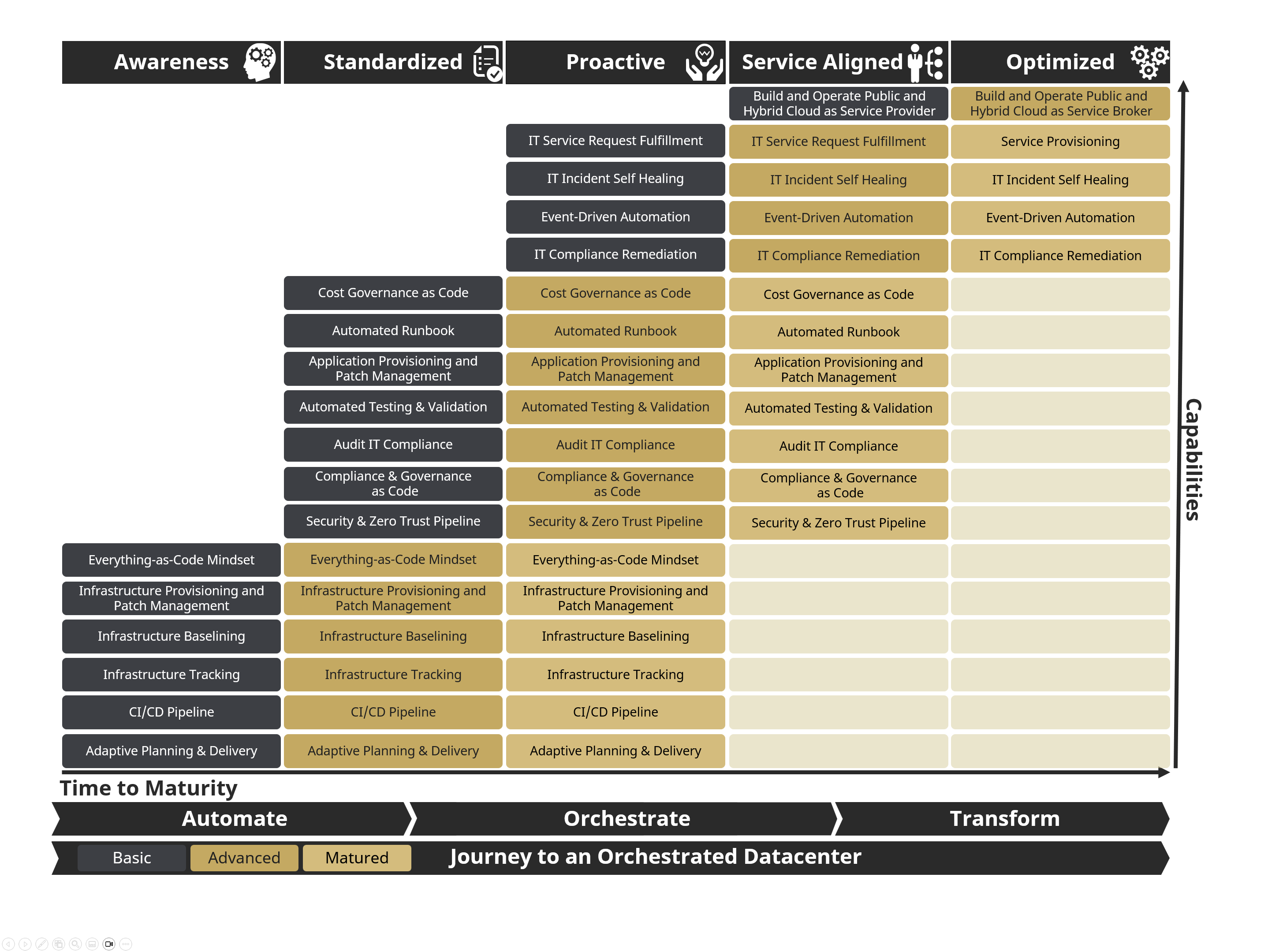Digital transformation has become a critical imperative for modern enterprises. As organizations face increasing pressure to improve efficiency, reduce costs, and accelerate innovation, the need for a structured approach to IT transformation has never been more apparent. This article outlines a comprehensive framework for understanding and implementing IT transformation, based on proven industry practices and real-world experience.
Understanding the Transformation Journey
The path to modern IT operations follows three distinct phases, each building upon the previous to create lasting operational excellence. At its core, this journey represents the evolution from manual, reactive IT operations to an automated, proactive service delivery model.

Glossary of critical terms from the image:
- Infrastructure baselining: The process of creating a "baseline" for infrastructure, including configurations and reference metrics. This allows monitoring of changes and ensures the stability of the environment.
- Cost Governance as Code: The approach of managing cost governance policies as code, enabling automation and consistent enforcement of these policies in cloud environments.
- Everything-as-Code mindset: A methodology in which every aspect of operations, infrastructure, and configurations is defined and managed as code, ensuring consistency, traceability, and automation.
- Event-driven automation: An automation model where specific actions are triggered by events, such as system alerts or infrastructure changes.
- Self-healing systems: Systems capable of automatically detecting problems or incidents and applying corrective solutions without human intervention.
- CI/CD Pipeline: "Continuous Integration/Continuous Delivery Pipeline", a process that enables automatic integration and deployment of code changes into development or production environments.
- Automated Runbook: A set of instructions or operational procedures that are automated to perform common IT tasks.
- Application Provisioning and Patch Management: The processes of installing, configuring, and updating applications, with proactive management of security patches.
- IT Compliance Remediation: Actions taken to correct non-compliance identified during IT audits and align systems with regulatory requirements.
- Security & Zero Trust Pipeline: A set of processes that apply "Zero Trust" security principles, where no user or system is automatically trusted.
Understanding this transformation framework is the first step toward modernizing IT operations. Each organization's journey will be unique, but the fundamental principles and progression remain consistent. By following this structured approach, organizations can transform their IT operations while ensuring that each step delivers measurable business value.
The Foundation: Automate
 The journey begins with the adoption of an Everything-as-Code mindset, where infrastructure, configuration, and operational procedures are defined and managed as code. This fundamental shift enables organizations to establish consistent, repeatable processes while eliminating manual errors and reducing operational overhead.
The journey begins with the adoption of an Everything-as-Code mindset, where infrastructure, configuration, and operational procedures are defined and managed as code. This fundamental shift enables organizations to establish consistent, repeatable processes while eliminating manual errors and reducing operational overhead.
Infrastructure baselining and tracking form the cornerstone of this phase, providing visibility and control over the entire IT environment. Organizations implement basic CI/CD pipelines and begin adopting adaptive planning practices, setting the stage for more advanced automation capabilities.
The Evolution: Orchestrate
 As automation capabilities mature, organizations progress to orchestrated workflows that coordinate multiple automated processes. This phase introduces sophisticated capabilities such as automated runbooks, event-driven automation, and self-healing systems that can detect and resolve common incidents without human intervention.
As automation capabilities mature, organizations progress to orchestrated workflows that coordinate multiple automated processes. This phase introduces sophisticated capabilities such as automated runbooks, event-driven automation, and self-healing systems that can detect and resolve common incidents without human intervention.
A key development during this phase is the implementation of automated testing and validation frameworks, ensuring that changes to infrastructure and applications meet quality and compliance requirements before deployment. Application provisioning and patch management become streamlined, reducing the operational burden on IT teams while improving security and reliability.
The Destination: Transform
 The final phase represents a fundamental shift in how IT services are delivered and consumed. Organizations evolve from traditional IT operations to become either service providers or service brokers, capable of delivering and managing cloud services with high efficiency and flexibility.
The final phase represents a fundamental shift in how IT services are delivered and consumed. Organizations evolve from traditional IT operations to become either service providers or service brokers, capable of delivering and managing cloud services with high efficiency and flexibility.
This transformation is characterized by advanced capabilities such as automated service provisioning, sophisticated cost governance as code, and fully automated IT service request fulfillment. Organizations at this stage can operate seamlessly across public and hybrid cloud environments, optimizing resource utilization while maintaining strict security and compliance controls.
Measuring Progress and Maturity
Progress along this transformation journey can be measured across five distinct maturity levels:
Awareness represents the initial understanding of automation opportunities and the beginning of basic infrastructure tracking. Organizations at this level are just starting to implement fundamental automation practices.
As organizations progress to the Standardized level, they establish consistent automation practices and begin implementing regular compliance auditing and automated testing frameworks.
The Proactive stage marks a significant shift toward predictive operations, with event-driven automation and self-healing capabilities becoming standard practice.
At the Service Aligned level, organizations achieve full service automation capabilities, operating as efficient service providers with integrated governance frameworks.
Finally, the Optimized state represents the pinnacle of IT transformation, where organizations function as sophisticated cloud service brokers with advanced cost optimization and complete operational automation.
Impact on Business Operations
This transformation journey delivers tangible benefits at each stage. Organizations typically experience:
- Reduced operational costs through elimination of manual tasks
- Improved security posture through consistent policy enforcement
- Enhanced service quality through automated testing and validation
- Accelerated service delivery through automated provisioning
- Better resource utilization through intelligent optimization
The journey to IT transformation is continuous, with new technologies and practices emerging regularly. Success requires a balanced approach that considers not just technology implementation, but also the necessary changes to processes, skills, and organizational culture.
Organizations must assess their current capabilities, define clear objectives, and create a realistic roadmap that delivers incremental value while building toward their long-term vision. This structured approach ensures sustainable transformation that aligns with business objectives while managing risk and complexity.
Partner for Success
At ICT.technology, we guide organizations through each stage of this transformation journey, ensuring that every step delivers measurable business value while building toward your strategic vision.
Transform your IT operations from a cost center to a strategic business enabler. Let us help you navigate the path to operational excellence, ensuring your technology foundation supports your business ambitions both today and tomorrow.
Contact us to begin your transformation journey!
















